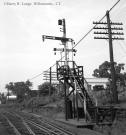
| Home | Open Account | Help | 359 users online |
|
Member Login
Discussion
Media SharingHostingLibrarySite Info |
Steam & Excursion > It's a train signal, but what does it do?Date: 08/14/06 22:30 It's a train signal, but what does it do? Author: choochoocharlie It's at Willamantic, CT. My Father took the photo probably in the late '40s and all it says on the negative sleeve is "crazy signal at Willamantic". Does anyone know what kind of a signal it is and what it does?
C.C.Chas.  Date: 08/14/06 22:58 Re: It's a train signal, but what does it do? Author: cs16 Looks like a somebodies idea of an early day position signal, complete with lanterns for night use.
Date: 08/15/06 05:14 Re: It's a train signal, but what does it do? Author: PaxtonCabin This is the best photo of this signal that I've ever seen!
Locally called "The Windmill Signal" it protected the junction of the Central Vermont's former New London Northern (North to South), New Haven's former New York and Boston Air Line (Northeast to Southwest) and New Haven's former Providence, Hartford & Fishkill (East to West). This junction did not have diamonds, rather each line curved in, paralleled the other two, crossed over and then separated again. The signal was built in the late 1800s, was operated by hand and lasted until at least 1961. I've got the instruction buried somewhere and will post it here when I find it. The CV is now Rail America's New England Central Railroad. The P,H&F is being rebuilt by the Providence & Worcester from Willimantic to Plainfield to handle coal and auto traffic off the NECR (things will get busier here very soon). The Air Line is a recreational trail as is the P,H&F as far west as Manchester where Rail America's Connecticut Southern uses the line into Hartford. -PRR 5711 Date: 08/15/06 17:55 Re: It's a train signal, but what does it do? Author: ddg Looks like Dietz "Vesta" hand lanterns, I have one in my collection marked "CVRR"
Date: 08/15/06 21:22 Re: It's a train signal, but what does it do? Author: rrman6 From the looks of the autos I'd guess it to be maybe even previous to the late 40's, although, they could have been somebodys old timers then. I can't quite make out what the one on the right is but would guess it to be in the mid to late 30's. If only the folks fueling those lanterns could know what the price of this lamp oil or kerosene would sell for today, they would be astounded. Great picture of a real collector and thanks for sharing. If I wasn't a railroad fan, I'd think the signals were someones king size set of balance scales..
Date: 08/15/06 22:26 Re: It's a train signal, but what does it do? Author: choochoocharlie Thanks 5711 for all of the great info on this mystery signal. At least it was a mystery to me, until now. TO members come to the rescue again with all the necessary info on some interesting railroad equipment. Thanks to all TO members for your kind help in answering all of the inqueries about photos and things with speed and accuracy. You people are what makes this group so interesting and successful........................... C.C.Chas.
Date: 08/16/06 16:24 Re: It's a train signal, but what does it do? Author: BulletBob Thank-you for the explanation. I just saw that thing in a rr video rental on the NH a couple of nights ago. There was no explanation about it so I wanted to revisit that part of the tape and slowly
go through it again. This really helps. Talk about great timing. Date: 08/18/06 12:07 Re: It's a train signal, but what does it do? Author: VERNON1946 I don't know about the technical (detailed) information. But here is a Country Answer to your question! Looks like a good place to film a train!!!! A Steam Train! A Union Pacific "Big Boy" Locomotive!....VERNON
Date: 08/18/06 12:59 Re: It's a train signal, but what does it do? Author: EL-SD45-3632 The signal is called a "Tilting Target", goe's back to the 1890's 1910's. They used a "Hook" to loop on the handle to lower the lantern to "refuel" it.
Date: 08/25/06 16:13 Re: It's a train signal, but what does it do? Author: retengr I was told years ago that this signal was of an English design
and there were probably no other signals like it in the US. It governed a crossing between the Central Vermont Railway, the New Haven Railroad's Hartford - Boston line and the New Haven Railroad's Air Line route (listed in the rules as "Chestnut Hill Route"). There was a 24 hour block station and train order office at this location and the operator had plenty to do: 1. Flag Bridge Street Crossing 2. Handle the junction switches 3. Operate the signal in conjunction with the position of the hand thrown switches 4. Handle blocking and train orders for the New Haven Railroad 5. Handle train orders etc for the Central Vermont Railway. The operator/switchtender had to be qualified on the rules and timetable of both the Central Vermont Railway and the New Haven Railroad. The need for this position and the signal was reduced after the floods of August, 1955 and even more so after the Central Vermont reduced their through freight train operation from two each way a day to one each way a day. To the best of my knowledge, all of the operators were New Haven people although the Central Vermont paid for a good portion of the expense of this facility. When the use of the signal ended and the operator's positions were abolished, the switches were left lined and locked for the Central Vermont but all trains on all routes had to stop to push a button to start up the signals for Bridge Street crossing before they could proceed through the area. s |